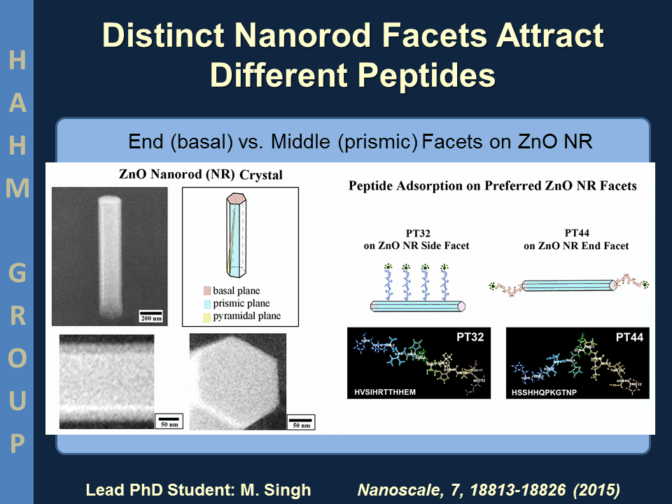Jong-in Hahm
 Office: 520 Regents Hall
Office: 520 Regents Hall
Phone: 202-687-5950
Fax: 202-687-6209
jh583@georgetown.edu
Lab web site https://jong-in-hahm.facultysite.georgetown.edu/
Education/Background
B.S. Seoul National University
Ph. D. The University of Chicago
Post-doc. Harvard University
Distinguished Achievement in Research Award (Georgetown University, 2016), KWiSE Woman Scientist Award (KSEA, 2016), ACS WCC Rising Star Award (American Chemical Society, 2013), Young Researchers on Advanced Materials Travel Award (NSF IME, 2012), ACS Progress/Dreyfus Lectureship Award (2008), ACS WCC Lectureship Award (2007), Grace Woodward Award in Engineering and Medicine (2005), Pearce Development Professor in Department of Chemical Engineering at Penn State University (2003).
Research Interests
Physical Chemistry, Nanomaterials Science, Biomedical Applications of Nanomaterials, Biotechnology, Fundamental Properties of Polymeric, Metallic, and Semi-conducting Nanomaterials

Dr. Hahm currently studies new materials, particularly molecular structures on the nanometer scale, for use as advanced molecular tools in promoting fundamental chemical research and in investigating a variety of biological systems. She also develops materials that can be applied to functions as diverse as molecular probes for improving genotyping methods, screening small molecules and early disease markers, and for facilitating fundamental chemical studies. Her current research centers on the synthesis of materials such as nanotubes and nanowires with interesting structures and functionality. She is working to develop methods for the controllable synthesis of these one-dimensional structures on various catalysts in order to produce functional nanomaterials to facilitate their applications in basic science and engineering. Her group is using a variety of polymers and biomaterials to grow the nanomaterials at tailored sites and with a defined geometry and orientation. Her research also focuses on the development and innovative use of nanomaterials such as carbon nanotubes as well as metallic and semiconductor nanowires for biomedical studies. Materials synthesized in her group are designed specifically for hosting individual biomolecules by controlling the chemical compositions and physical dimensions of the nanomaterials during synthesis. Materials grown this way could be used as high-resolution biomolecular probes for atomic force microscopy, biomolecular electrical sensors, enhanced fluorescence detection platforms, and advanced protein/drug delivery templates.
Selected Recent Publications – (Click here for more).
● J. Truong, A. Stoner, M. R. C. Sytu, T. R. Tatlock, D. H. Cho, J. Hahm, Elucidation of strain-dependent, zinc oxide nanorod response for nanorod-guided fluorescence intensity, Nanomaterials, 12, 3558 (2022). Nanomaterials, 12, 3558 (2022).
● D. H. Cho, T. Xie, P. J. Mulcahey, N. P. Kelleher and J. Hahm, Distinctive protein adsorption mechanism and kinetics of immunoglobulin G on a nanoscale polymer surface, Langmuir, 38, 1458-1470 (2022).
● D. H. Cho and J. Hahm, Protein-polymer interaction characteristics unique to nanoscale interfaces, J. Phys. Chem. B, 125, 6040-6057 (2021). Invited Article
● D. H. Cho, T. Xie, J. Truong, A. C. Stoner, and J. Hahm, Recent advances towards single biomolecule level understanding of protein adsorption phenomena unique to nanoscale polymer surfaces with chemical variations, Nano Res., 5, 1295–1317 (2020).
● B. Chon, J. Truong, M. Hansen, J. Hahm*, and Y. J. Lee*, Position- and polarization-specific waveguiding of multi-emissions in single ZnO nanorods, ACS Photonics, 6,1416-1424 (2019) (*: corresponding authors)
● M. Hansen, J. Truong, B. Szychowski, T. Xie, M.-C. Daniel, and J. Hahm, Single nanomaterial level investigation of ZnO nanorod sulfidation reaction via position resolved confocal Raman spectroscopy, Nanoscale,11, 1147-1158 (2019).
● T. Xie, J. Chattoraj, P. J. Mulcahey, N. P. Kelleher, E. D. Gado, and J. Hahm, Revealing principal attributes of protein adsorption on block copolymer surfaces with direct experimental evidence at the single protein level, Nanoscale, 10, 9063-9076 (2018).
● M. Hansen, J. Truong, T. Xie, and J. Hahm, Spatially distinct Raman scattering characteristics of individual ZnO nanorods under controlled polarization: Intense end scattering from forbidden modes, Nanoscale, 9, 8470-8480 (2017).
● J. Truong, M. Singh, M. Hansen, and J. Hahm, Polarization-resolved mechanistic investigation of fluorescence signal intensification on zinc oxide nanorod ends, Nanoscale, 9, 8164-8175 (2017). NIHMS882194
● M. Singh, J. Truong, W. B. Reeves and J. Hahm, Emerging cytokine biosensors with optical detection modalities and nanomaterial enabled signal enhancement, Sensors, 14, 428 (2017). Featured Article PMC5335944
● T. Xie, A. Vora, P. J. Mulcahey, S. E. Nanescu, M. Singh, D. S. Choi, J. K. Huang, C. Liu, D. P. Sanders, and J. Hahm, Surface assembly configurations and packing preferences of fibrinogen mediated by the periodicity and alignment control of block copolymer nanodomains, ACS Nano, 10, 7705-7720 (2016).
● J. Hahm, Fundamental properties of one-dimensional zinc oxide nanomaterials and implementations in various detection modes of enhanced biosensing, Annu. Rev. Phys. Chem., 67, 691-717, Invited Review (2016). PMC4894344
● S. Song, T. Xie, K. Ravensbergen, and J. Hahm, Ascertaining effects of nanoscale polymeric interfaces on competitive protein adsorption at the individual protein level, Nanoscale, 8, 3496 – 3509 (2016).
● M. Singh, A. Alabanza, L. E. Gonzalez, W. Wang, W. Brian Reeves, and J. Hahm, Ultratrace level determination and quantitative analysis of kidney injury biomarkers in patient samples attained by zinc oxide nanorods, Nanoscale, 8, 4613-4622 (2016). PMC4760885
● M. Singh, R. Jiang, H. Coia, D. S. Choi, A. Alabanza, J. Y. Chang, J. Wang, and J. Hahm, Insights into factors affecting the presence, degree, and temporal stability of fluorescence intensification on ZnO nanorod ends, Nanoscale, 7, 1424-1436 (2015). PMC4285569
● S. Zhao, D. S. Choi, T. Lee, A. K. Boyd, P. Barbara, E. V. Keuren and J. Hahm, Indium tin oxide nanowire networks as effective UV/VIS photodetection platforms, J. Phys. Chem. C. 119, 14483-14489, Invited Article (2015).
● S. Song, K. Ravensbergen, A. Alabanza, D. Soldin, and J. Hahm, Distinct adsorption configurations and self-assembly characteristics of fibrinogen on chemically uniform and alternating surfaces including block copolymer nanodomains, ACS Nano, 8, 5257-5269 (2014). PMC4046797
● J. Hahm, Fundamentals of nanoscale polymer-protein interaction and potential contributions to solid-state nanobioarrays, Langmuir, 30, 9891-9904 (2014) Invited Feature Article, Front Cover Article. PMC4148170
● D. S. Choi, D. Y. Joh, T. Lee, M. Milchak, H. Zhou, Y. Kang, and J. Hahm, Position- and orientation-controlled polarized light interaction of individual indium tin oxide nanorods, Appl. Phys. Lett. 104, 083112 (2014). PMC3977747
